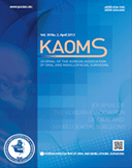Journal of the Korean Association of Oral and Maxillofacial Surgeons
- P-ISSN2234-7550
- E-ISSN2234-5930
- SCOPUS, KCI, ESCI
 ISSN : 2234-7550
ISSN : 2234-7550
Are critical size bone notch defects possible in the rabbit mandible?
Teja Guda (Department of Biomedical Engineering, University of Texas at San Antonio, San Antonio, TX, USA)
David T. Silliman (Dental and Trauma Research Detachment, Fort Sam Houston)
Robert G. Hale (Dental and Trauma Research Detachment, Fort Sam Houston)
Pamela R. Brown Baer (Dental and Trauma Research Detachment, Fort Sam Houston)
Abstract
Objectives: Small animal maxillofacial models, such as non-segmental critical size defects (CSDs) in the rabbit mandible, need to be standardized for use as preclinical models of bone regeneration to mimic clinical conditions such as maxillofacial trauma. The objective of this study is the establishment of a mechanically competent CSD model in the rabbit mandible to allow standardized evaluation of bone regeneration therapies. Materials and Methods: Three sizes of bony defect were generated in the mandibular body of rabbit hemi-mandibles: 12 mm×5 mm, 12 mm×8 mm, and 15 mm×10 mm. The hemi-mandibles were tested to failure in 3-point flexure. The 12 mm×5 mm defect was then chosen for the defect size created in the mandibles of 26 rabbits with or without cautery of the defect margins and bone regeneration was assessed after 6 and 12 weeks. Regenerated bone density and volume were evaluated using radiography, micro-computed tomography, and histology. Results: Flexural strength of the 12 mm×5 mm defect was similar to its contralateral; whereas the 12 mm×8 mm and 15 mm×10 mm groups carried significantly less load than their respective contralaterals (P<0.05). This demonstrated that the 12 mm×5 mm defect did not significantly compromise mandibular mechanical integrity. Significantly less (P<0.05) bone was regenerated at 6 weeks in cauterized defect margins compared to controls without cautery. After 12 weeks, the bone volume of the group with cautery increased to that of the control without cautery after 6 weeks. Conclusion: An empty defect size of 12 mm×5 mm in the rabbit mandibular model maintains sufficient mechanical stability to not require additional stabilization. However, this defect size allows for bone regeneration across the defect. Cautery of the defect only delays regeneration by 6 weeks suggesting that the performance of bone graft materials in mandibular defects of this size should be considered with caution.
- keywords
- Bone regeneration, Rabbit, Mandible, Micro-computed tomography, Cautery
- Downloaded
- Viewed
- 0KCI Citations
- 0WOS Citations